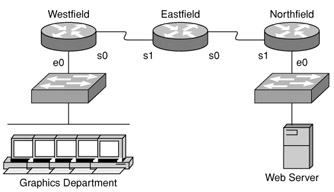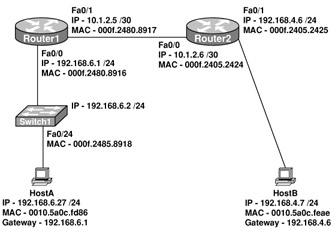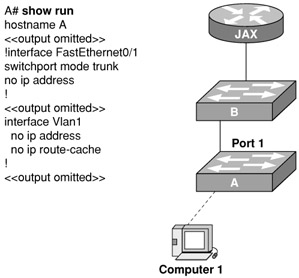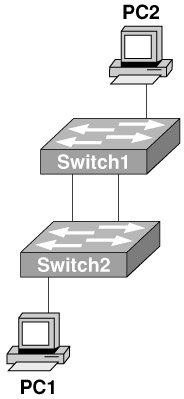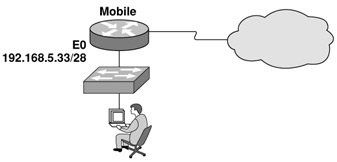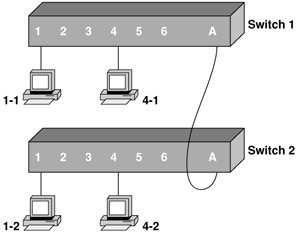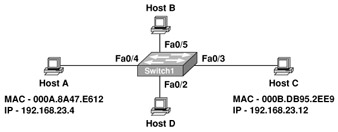CCNA-Practice Test 4
Directions: For each of the following questions, select the choice that best answers the question or completes the statement.
| 1. | Look at the following diagram. Which route will be found in the routing table of the Main router?
Main#debug ip rip RIP protocol debugging is on Main# *Mar 1 17:43:00.567: RIP: received v1 update from 192.168.255.21 on Serial0/0 *Mar 1 17:43:00.571: 192.168.2.0 in 2 hops *Mar 1 17:43:00.571: 192.168.255.16 in 1 hops *Mar 1 17:43:41.419: RIP: received v1 update from 192.168.255.26 on Serial0/1 *Mar 1 17:43:41.423: 192.168.2.0 in 1 hops *Mar 1 17:43:41.427: 192.168.255.16 in 1 hops *Mar 1 17:43:55.099: RIP: sending v1 update to 255.255.255.255 via Serial0/0 (192.168.255.22) *Mar 1 17:43:55.103: RIP: build update entries *Mar 1 17:43:55.103: network 192.168.2.0 metric 2 *Mar 1 17:43:55.107: subnet 192.168.255.24 metric 1 *Mar 1 17:43:55.111: RIP: sending v1 update to 255.255.255.255 via Serial0/1 (192.168.255.25) *Mar 1 17:43:55.115: RIP: build update entries *Mar 1 17:43:55.119: subnet 192.168.255.20 metric 1 Figure 4-1 | | ||||||||||||||||||||||||||||||||||||||||||||||||||
| 2. | Look at the following diagram. An access list has been designed to prevent Telnet traffic from the Graphics Department from reaching the web server attached to the Northfield router. On which router, which interface, and in what direction should the access list be placed to most efficiently implement this list? (Choose three.)
| | ||||||||||||||||||||||||||||||||||||||||||||||||||
| 3. | You're testing an ISDN circuit that uses PPP between two IP hosts. Match the indicator in the left column with the OSI layer on the right that it confirms.
| | ||||||||||||||||||||||||||||||||||||||||||||||||||
| 4. | Look at the following diagram. HostA has established a Telnet session with HostB. Which intermediate device examines the information at OSI layers 1-2 only?
| | ||||||||||||||||||||||||||||||||||||||||||||||||||
| 5. | You are unable to telnet to a router at address 203.125.12.1 from a workstation with the IP address 203.125.12.23. You suspect that there is a problem with your protocol stack. Which of the following actions is most likely to confirm your diagnosis?
| | ||||||||||||||||||||||||||||||||||||||||||||||||||
| 6. | Look at the following diagram. A network technician enters the following line into the router:
Tidmore1(config)# no access-list 106 permit ip any any What is the effect of this configuration?
| | ||||||||||||||||||||||||||||||||||||||||||||||||||
| 7. | Without a loopback interface, which of the following accurately describes what an OSPF router would use for the router ID if all OSPF routers in one area were configured with the same priority value?
| | ||||||||||||||||||||||||||||||||||||||||||||||||||
| 8. | Look at the following diagram. The network has been configured with STP disabled. HostA sends an ARP request for the IP address of a site on the Internet. What will happen to this ARP request? (Choose two.)
| | ||||||||||||||||||||||||||||||||||||||||||||||||||
| 9. | On which OSI layer does the protocol operate that imparts the information you get by using the show cdp neighbors command?
| | ||||||||||||||||||||||||||||||||||||||||||||||||||
| 10. | Which command will configure a default route on a router?
| | ||||||||||||||||||||||||||||||||||||||||||||||||||
| 11. | Look at the following diagram. Computer 1 is consoled into switch A. Telnet connections and pings run from the command prompt on switch A fail. Which of the following could cause this problem?
| | ||||||||||||||||||||||||||||||||||||||||||||||||||
| 12. | Which of the following statements are true regarding the command ip route 172.16.3.0 255.255.255.0 192.168.2.4? (Choose two.)
| | ||||||||||||||||||||||||||||||||||||||||||||||||||
| 13. | What are the possible trunking modes for a switch port? (Choose three.)
| | ||||||||||||||||||||||||||||||||||||||||||||||||||
| 14. | Of these choices, which three host addresses are valid members of networks that can be routed across the Internet?
| | ||||||||||||||||||||||||||||||||||||||||||||||||||
| 15. | Look at the following diagram. Assuming all hosts and servers are in the same VLAN, which statement is correct about the internetwork shown in the diagram?
| | ||||||||||||||||||||||||||||||||||||||||||||||||||
| 16. | Look at the following diagram. When PC1 sends an ARP request for the MAC address of PC2, network performance slows dramatically, and the switches detect an unusually high number of broadcast frames. What is the most likely cause of this?
| | ||||||||||||||||||||||||||||||||||||||||||||||||||
| 17. | The command ip route 192.168.24.64 255.255.255.192 192.168.8.2 100 was configured on a router named Corporate. No routing protocols or other static routes are configured on the Corporate router yet. Which statement is true about this command?
| | ||||||||||||||||||||||||||||||||||||||||||||||||||
| 18. | Choose the command that will configure a switch port to use the IEEE standard method of adding VLAN membership information into Ethernet frames.
| | ||||||||||||||||||||||||||||||||||||||||||||||||||
| 19. | If you needed to permit Internet access for the hosts in your network assigned addresses in the 192.168.8.0 through 198.168.15.255 range, which wildcard mask would you employ to achieve that objective?
| | ||||||||||||||||||||||||||||||||||||||||||||||||||
| 20. | Which command displays all the EIGRP feasible successor routes known to a router?
| | ||||||||||||||||||||||||||||||||||||||||||||||||||
| 21. | Which sequence of actions allows telneting from a user's PC to a router using TCP/IP?
| | ||||||||||||||||||||||||||||||||||||||||||||||||||
| 22. | Which of the following are options for Frame Relay LMI types? (Choose three.)
| | ||||||||||||||||||||||||||||||||||||||||||||||||||
| 23. | What is the subnetwork number of a host with an IP address of 172.16.210.0/22?
| | ||||||||||||||||||||||||||||||||||||||||||||||||||
| 24. | Look at the following diagram. What should be the IP address of the host?
| | ||||||||||||||||||||||||||||||||||||||||||||||||||
| 25. | Look at the following diagram. The network administrator has configured the switches in the school network to use VTP. The switches are not sharing VLAN information. Which sequence of commands should be issued to correct this problem?
Figure 4-10 | | ||||||||||||||||||||||||||||||||||||||||||||||||||
| 26. | Which of the following IP addresses can be assigned to host devices? (Choose two.)
| | ||||||||||||||||||||||||||||||||||||||||||||||||||
| 27. | Look at the following diagram. Assume that ports 1 through 3 are assigned to VLAN1 and ports 4 through 6 are assigned to VLAN2 on each switch. The switches are interconnected over a trunked link. Which of the following conditions verify proper VLAN and trunk operation? (Choose three.)
| | ||||||||||||||||||||||||||||||||||||||||||||||||||
| 28. | The TFR Company is implementing dialup services to enable remote office employees to connect to the local network. The company uses several different layer 3 protocols on the network. Authentication of the users connecting to the network is required for security. Additionally, some employees will be dialing long distance and will need callback support. Which protocol is the best choice for these remote access services?
| | ||||||||||||||||||||||||||||||||||||||||||||||||||
| 29. | Look at the following diagram. Switch1 has just been restarted and has passed the POST routine. When Host A begins communicating with Host C, what will the switch do?
| | ||||||||||||||||||||||||||||||||||||||||||||||||||
| 30. | A network administrator is designing a Cisco network for a large company. The network must be able to use minimal bandwidth for routing updates; converge quickly; and support VLSM, CIDR, IP and IPX. Which routing protocol best fits the requirements of this network?
| | ||||||||||||||||||||||||||||||||||||||||||||||||||
| 31. | When a new trunk link is configured on an IOS-based switch, which VLANs are allowed over the link?
| | ||||||||||||||||||||||||||||||||||||||||||||||||||
| 32. | Which command displays RIP routing updates as they are sent and received by the router?
| | ||||||||||||||||||||||||||||||||||||||||||||||||||
| 33. | In which of the following options would multiple copies of the same unicast frame be the most likely to be relayed in a switched LAN?
| | ||||||||||||||||||||||||||||||||||||||||||||||||||
| 34. | Look at the following diagram. How can a network administrator ensure that the STP election process will result in Switch B being elected as the root switch?
| | ||||||||||||||||||||||||||||||||||||||||||||||||||
| 35. | A network administrator issues the ping 192.168.2.5 command and successfully tests connectivity to a host that has been newly connected to the network. Which protocols were used during the test? (Choose two.)
| | ||||||||||||||||||||||||||||||||||||||||||||||||||
| 36. | You've just inserted a new router into an established OSPF network, but the networks attached to the recently added router aren't showing up in the routing tables of the other OSPF routers. By looking at the information in the partial configuration given below, what's causing this issue?
Router(config)# router ospf 1 Router(config-router)# network 10.0.0.0 255.0.0.0 area 0
| | ||||||||||||||||||||||||||||||||||||||||||||||||||
| 37. | Match the security features in the column on the left to the exact security risks they help protect against in the right column. (You'll have one left over.)
| | ||||||||||||||||||||||||||||||||||||||||||||||||||
| 38. | Which command is required to apply an access list on a virtual terminal line of a router?
| | ||||||||||||||||||||||||||||||||||||||||||||||||||
| 39. | A Cisco router has been configured, and the copy running-config startup-config command has been issued. When the router is power cycled, the router prompts with "Would you like to enter the initial configuration dialog? [yes/no]:". Why does this happen?
| | ||||||||||||||||||||||||||||||||||||||||||||||||||
| 40. | An administrator is configuring a Catalyst switch with VLAN information that must be automatically distributed to other Catalyst switches in the network. What conditions must be met in order for the VLANs configured on this switch to be automatically configured on other switches? (Choose three.)
| | ||||||||||||||||||||||||||||||||||||||||||||||||||
| 41. | Look at the following diagram. You have been asked to diagnose a problem with the network shown. The following symptoms have been observed: None of the user hosts can access the Internet; none of the user hosts can access the server in VLAN9; host A can ping host B; host A cannot ping host C or host D; and host C can ping host D. What can cause these symptoms?
| | ||||||||||||||||||||||||||||||||||||||||||||||||||
| 42. | Your security policy dictates that only one host can be permitted to dynamically attach to each interface, and if this policy is violated, the interface should immediately shut down. Choose the two commands you need to configure on the 2950 Catalyst switch to implement your policy.
| | ||||||||||||||||||||||||||||||||||||||||||||||||||
| 43. | You're configuring a router to act as a hub within a Frame Relay hub-and-spoke topology. Why should you opt for using point-to-point subinterfaces instead of a multipoint interface?
| | ||||||||||||||||||||||||||||||||||||||||||||||||||
| 44. | Look at the following diagram. Two switches, named Top and Bottom, connect through ports configured as trunks. The trunk ports on both switches have been configured correctly, and both interfaces are up. VTP, however, is not passing VLAN information between the two switches. Based on the output of the show vtp status command from both switches, what is the problem?
Figure 4-15 | | ||||||||||||||||||||||||||||||||||||||||||||||||||
| 45. | What is the purpose of spanning tree in a switched LAN?
| | ||||||||||||||||||||||||||||||||||||||||||||||||||
| 46. | Which two commands would you use to configure running OSPF, plus adding network 192.168.16.0/24 to OSPF area 0?
| | ||||||||||||||||||||||||||||||||||||||||||||||||||
| 47. | Which command is required for connectivity in a Frame Relay network if Inverse ARP is not operational?
| | ||||||||||||||||||||||||||||||||||||||||||||||||||
| 48. | Which statements describe the routing protocol OSPF? (Choose three.)
| | ||||||||||||||||||||||||||||||||||||||||||||||||||
| 49. | You've configured an interface with the access list shown. Based on the access list, list which information packet in the left column will be permitted and which packets will be denied?
Access-list 107 deny tcp 207.16.12.0 0.0.3.255 any eq http Access-list 107 permit ip any any
| | ||||||||||||||||||||||||||||||||||||||||||||||||||
| 50. | You've configured the Ethernet 0 interface of a router with address 10.64.0.1. 255.224.0.0 and the Ethernet 1 interface with address 10.96.0.1/11. Choose the two commands you can use to configure RIP version 1 on this router so it will advertise both networks to the neighboring routers.
| | ||||||||||||||||||||||||||||||||||||||||||||||||||
| 51. | Look at the following diagram. RouterA is unable to reach RouterB. Both routers are running IOS version 12.0. After reviewing the command output and graphic, what is the most likely cause of the problem?
| | ||||||||||||||||||||||||||||||||||||||||||||||||||
| 52. | Look at the following diagram. Switches A and B have been configured with a trunked link that has been verified as working correctly. However, VTP is not propagating VLANs from one switch to the other. Based on the command output shown, what is the problem?
| | ||||||||||||||||||||||||||||||||||||||||||||||||||
| 53. | Which functions do routers perform when routing a packet? (Choose two.)
| | ||||||||||||||||||||||||||||||||||||||||||||||||||
| 54. | What does a layer 2 switch do if it receives a frame with a destination MAC address that is not found in its MAC address table?
| | ||||||||||||||||||||||||||||||||||||||||||||||||||
| 55. | Which tables of EIGRP route information are held in RAM and maintained through the use of hello and update packets? (Choose two.)
| | ||||||||||||||||||||||||||||||||||||||||||||||||||
Answers
| 1. | B Explanation: B. The route via 192.168.255.26 has a lower metric than the route via 192.168.255.21. | ||||||||||
| 2. | A, D, E Explanation: A, D, E. Extended access lists should be placed as close to the source as possible. | ||||||||||
| 3. |
Explanation:
| ||||||||||
| 4. | A Explanation: A. Switches only evaluate layer 1-2 information. Routers look at layers 1-3, and the destination host examines all layers. | ||||||||||
| 5. | D Explanation: D. If you suspect an issue with the local protocol stack, pinging the loopback address will tell you if that is the problem. | ||||||||||
| 6. | B Explanation: B. Once you type in "no access-list number," the whole list is gone. And in this question, the LAN segment has no access-list effecting the connection to the Internet or anywhere else. B is the best answer. You cannot remove one line from an access-list unless you are using named access-lists. | ||||||||||
| 7. | C Explanation: C. In the election process of OSPF routers, the priority value is checked first; by default, all routers have a value of one. If a loopback interface is configured, the interface with the highest IP address is used. If there is no loopback interface, then the active interface with the highest IP address is used. | ||||||||||
| 8. | C, E Explanation: C, E. With STP disabled, the looped topology creates a broadcast storm. The router responds to the ARP request. | ||||||||||
| 9. | B Explanation: B. Cisco Discovery Protocol (CDP) is a Cisco proprietary protocol that works at the Data Link layer. | ||||||||||
| 10. | D Explanation: D. A default route is created by assigning a static route with the destination and mask all set to zeros. | ||||||||||
| 11. | D Explanation: D. When a switch cannot ping or telnet any other hosts, including those on its own subnet, the most likely cause is a misconfiguration of the local IP information. | ||||||||||
| 12. | A, B Explanation: A, B. This is a standard static route. Because no administrative distance is specified, the default will be used. | ||||||||||
| 13. | B, C, D Explanation: B, C, D. The three possible trunking modes include on, which means the port is configured to always be a trunk port and attempts to make the port on the far end of the segment a trunk port as well. This negotiation of trunk status is done using the Dynamic Trunking Protocol (DTP). The next mode is desirable, which means the port wishes to be a trunk port and sends DTP frames, but can also be an access port. The other end is not a trunk port. The third mode is auto, which means the port becomes a trunk port if it receives DTP frames to become one; however, it does not send DTP frames to change the other port. | ||||||||||
| 14. | C, E, F Explanation: C, E, F. To answer this question, you must know the private address ranges. There is a range in each of the classes of addresses 10.0.0.0-10.255.255.255, 172.16.0.0-172.31.255.255, and 192.168.0.0-192.168.255.255. Any of the options in these ranges will not be routed on the Internet. | ||||||||||
| 15. | C Explanation: C. The question states that all hosts and servers are in the same VLAN, which implies that the server and the host can communicate without going through a router. | ||||||||||
| 16. | C Explanation: C. If spanning tree is not running when there are loops in the topology, broadcasts will cause broadcast storms. | ||||||||||
| 17. | E Explanation: E. Because no other routing is configured on the router, this static route will be the only entry in the routing table other than connected interfaces. The 192.168.24.124 host is within the address range specified in the static route. | ||||||||||
| 18. | F Explanation: F. There are two trunking encapsulation methods: ISL, which is Cisco propriety; and 802.1q, which is not proprietary. Use the command dot1q when using 802.1q. | ||||||||||
| 19. | D Explanation: D. A wildcard is always one less than the block size. The third octet has a block size of 8, and the fourth octet has a block size of 256. This makes the mask 0.0.7.255. | ||||||||||
| 20. | C Explanation: C. Feasible successor routes are stored in the topology table. They are not shown in the routing table. | ||||||||||
| 21. | D Explanation: D. When attaching directly to a router's interface without a hub or switch in the middle, a crossover cable must be used. You cannot telnet using your PC's COM port. | ||||||||||
| 22. | C, E, F Explanation: C, E, F. The three LMI types supported by Cisco routers are Cisco, ANSI, and Q933a. | ||||||||||
| 23. | C Explanation: C. The 172.16.208.0/22 subnetwork has hosts 172.16.208.1 through 172.16.211.254. | ||||||||||
| 24. | C Explanation: C. The subnet 192.168.5.32/28 has hosts 192.168.5.33 through 192.168.5.36. | ||||||||||
| 25. | B Explanation: B. All switches that share the same VLAN information need to have the same VTP domain name configured. | ||||||||||
| 26. | B, F Explanation: B, F. A is a subnetwork address, C is localhost, D is a multicast address, and E is a broadcast address. Only B and F are valid host addresses (all host bits are not all ones or zeros). | ||||||||||
| 27. | A, D, E Explanation: A, D, E. In this case, there is no router to route between the two VLANs, and thus your hosts should be able to ping only other hosts in the same VLAN. A and E show that hosts in one VLAN can ping hosts in the same VLAN on the other switch. | ||||||||||
| 28. | D Explanation: D. Only PPP meets all the requirements; dialup support, authentication, multiple layer-3 protocols, and callback are all supported by PPP. | ||||||||||
| 29. | C Explanation: C. The switch will learn the source MAC address from the frames that are received on the switchport. | ||||||||||
| 30. | E Explanation: E. Of the routing protocols listed, only EIGRP supports IPX. It also supports the other items listed in the question, as do B and D. | ||||||||||
| 31. | A Explanation: A. By default, all defined VLANs are allowed on configured trunk links. | ||||||||||
| 32. | C Explanation: C. Only a debug command can show you updates as they are sent and received. The correct command for RIP is debug ip rip. | ||||||||||
| 33. | D Explanation: D. If you do not have spanning-tree enabled on your switches, and you have redundant links, you will have broadcast storms and multiple frame copies. | ||||||||||
| 34. | B Explanation: B. A lower assigned priority always results in a switch being elected the root switch. | ||||||||||
| 35. | A, E Explanation: A, E. In order to ping, an IP must be resolved to a MAC address to properly frame the packet. This requires an ARP request. Additionally, a ping uses ICMP to generate a request and reply. | ||||||||||
| 36. | C Explanation: C. OSPF uses an inverse mask to configure the network statement. The mask in this example should be 0.255.255.255. | ||||||||||
| 37. |
Explanation:
| ||||||||||
| 38. | A Explanation: A. The access-class command is used directly on the VTY line to apply an access list. | ||||||||||
| 39. | C Explanation: C. This configuration register setting will cause the router to boot, ignoring the startup config. It is used in password recovery; however, if this register remains set, the router will always boot without checking for a startup config. | ||||||||||
| 40. | A, B, D Explanation: A, B, D. In order for VTP to work properly, all switches must be in the same VTP domain. Additionally, the switch that will share its VLAN configuration needs to be a VTP server, and the switches must be connected using trunk links. | ||||||||||
| 41. | B Explanation: B. This router interface is required to both access the Internet and route between VLANs. | ||||||||||
| 42. | A, D Explanation: A, D. By using the switchport port-security command, you can implement a security policy on your Catalyst switches. | ||||||||||
| 43. | A Explanation: A. In a case where split horizon is the problem, split horizon defines the rule "it is never useful to send routing information back in the direction from which it came." With this rule in place, routing updates that come from spoke routers are never relayed from the hub router. By implementing point-to-point links and subinterfaces on the spoke router, the routing protocol looks at each of the subinterfaces as separate physical links, allowing the updates to go between each point-to-point link and update the spoke routers. | ||||||||||
| 44. | A Explanation: A. These two VTP domain names do not match, and thus the switches cannot exchange VTP information. | ||||||||||
| 45. | C Explanation: C. The Spanning Tree Protocol is used to prevent loops in the layer-2 switching topology by controlling or blocking the use of redundant links. In a layer-2 network, redundant links are not a bad thing, unless they are uncontrolled, because they provide a secondary path if the primary fails, thus eliminating single points of failure. | ||||||||||
| 46. | A, E Explanation: A, E. When configuring OSPF to route on a network, the OSPF process must be started, using the router OSPF <process id> command. Then, while in the router configuration mode, you can use the network command to add a network and enable interfaces to operate in OSPF. The network command in OSPF includes the network, a wildcard bit mask, and the area to which you want the network to belong. | ||||||||||
| 47. | B Explanation: B. If inverse ARP is not operational, you must manually map the DLCI to upper-layer addresses. | ||||||||||
| 48. | A, C, E Explanation: A, C, E. OSPF supports VLSM, and through the use of areas, it can confine network instability to a single portion of the network. Additionally, it gives the administrator extensive control over routing updates. | ||||||||||
| 49. |
Explanation:
| ||||||||||
| 50. | C, D Explanation: C, D. RIP, IGRP and EIGRP are all configured that same way: with classful addresses, which means all default host bits off. In this question, two networks are using the 10.0.0.0 classful network address. If you are studying for your CCNA exam, it would be wise to understand this type of configuration. | ||||||||||
| 51. | C Explanation: C. The Frame Relay map statement is incorrect on RouterA. The other information is fine. | ||||||||||
| 52. | C Explanation: C. The VTP domain name must be the same on both switches in order for them to share VLAN information. In this case, the two switches have different VTP domain names. | ||||||||||
| 53. | A, C Explanation: A, C. When forwarding a packet, a router must switch the packet from one interface to another. In order to know which interface to switch the packet to, the router must perform path selection. Routers do not forward ARP requests, they do not assign VLAN membership, and they do not modify the destination host address (although they do read it to make the path-selection decision). | ||||||||||
| 54. | C Explanation: C. When the destination address is not in the forwarding table, a switch forwards the frame out all ports except the one on which it was received. This is called flooding the frame. | ||||||||||
| 55. | A, D Explanation: A, D. EIGRP maintains a neighbor table. If a router stops sending out updates, it is removed from the neighbor table. Additionally, all routes are kept in the topology table. Only preferred routes are surfaced to the routing table. |
